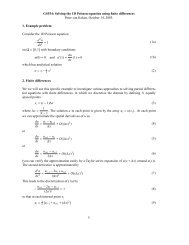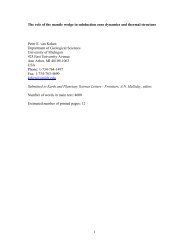Quantitative paleoenvironmental and paleoclimatic reconstruction ...
Quantitative paleoenvironmental and paleoclimatic reconstruction ...
Quantitative paleoenvironmental and paleoclimatic reconstruction ...
Create successful ePaper yourself
Turn your PDF publications into a flip-book with our unique Google optimized e-Paper software.
ARTICLE IN PRESS<br />
N.D. Sheldon, N.J. Tabor / Earth-Science Reviews xxx (2009) xxx–xxx<br />
33<br />
Fig. 19. Cross plot of δ 13 C values of paleosol calcite samples (crosses <strong>and</strong> blue open circles) <strong>and</strong> vascular plant total organic matter versus age (in years). This dataset consists of 2615<br />
calcite <strong>and</strong> 2148 organic matter data points compiled from peer-reviewed, published literature. Although many more pedogenic calcite <strong>and</strong> organic matter data points have been<br />
reported in the literature, only samples that (1) have radiometric, paleomagnetic or biostratigraphic age constraints <strong>and</strong> (2) are tabulated are included herein. Calcite d13C values are<br />
divided into open blue circles that represent the review data of Ekart <strong>and</strong> others (1999) <strong>and</strong> black crosses, which represent calcite d13C values from various studies (Srivastava, 2001;<br />
Magaritz et al., 1981; Deutz et al., 2001; Schlesinger, 1985; Quade et al., 2004; Quade <strong>and</strong> Cerling, 1995; Fox <strong>and</strong> Koch, 2003; Dever et al., 1988; Sinha et al., 2006; Cerling, 1992; Clyde<br />
et al., 2001; Behrensmeyer et al., 2007; Koch et al., 1995; Nordt et al., 2002; Alonso-Zarza <strong>and</strong> Tanner, 2006; Robinson et al., 2002; Quade et al., 1994; Ekart et al., 1999; Cerling et al.,<br />
1991; Sinha <strong>and</strong> Stott, 1994; Andrews et al., 1995; Ghosh et al., 1995; Ghosh et al., 2001; Suchecki et al., 1988; Purvis <strong>and</strong> Wright, 1991; Kenny <strong>and</strong> Neet,1993; Mora et al., 1996; Muchez<br />
et al., 1993; Prochnow et al., 2006; Tabor et al., 2004a,b; Mack et al., 1991; T<strong>and</strong>on et al., 1995; Retallack et al., 2004a,b; Bowen et al., 2001; Bowen et al., 2005). Numerical age data<br />
were taken directly from ages that were reported in the literature. Vertical drop lines on graph depict time boundaries for geological Epochs, Periods <strong>and</strong> Eras according to the<br />
timescale of Gradstein et al. (2004). Some numerical age dates for the calcite δ 13 C data that are based upon biostratigraphic- <strong>and</strong> magnetostraphic- correlation to out-of-date time<br />
scales may differ slightly from numerical correlations to the timescale of Gradstein et al. (2004).<br />
paleoatmospheric pCO 2 . Negative values of pCO 2 have no physical<br />
meaning, <strong>and</strong> could be interpreted to represent calcite that formed<br />
under closed (or semi-closed) system, 1-component soil CO 2 mixing,<br />
or formation in the presence of oxidizing organic matter that is<br />
isotopically more negative than those shown in Fig. 19. Calcite δ 13 C<br />
values that are more positive than this lower limit may be interpreted<br />
as having formed in the presence of open-system, 2-component<br />
mixing of CO 2 derived from in situ oxidation of organic matter <strong>and</strong> CO 2<br />
from the global troposphere. The resulting atmospheric pCO 2<br />
estimates are determined by the assumed concentration of soil CO 2 .<br />
The thin red lines depict calcite δ 13 C values for 2-component soils with<br />
a total soil CO 2 concentration of 5000 ppmV <strong>and</strong> atmospheric pCO 2<br />
values of 1, 5, <strong>and</strong> 10 PAL. Within the context of the assumed variables<br />
in this model of 2-component soil CO 2 mixing, paleosol calcite δ 13 C<br />
values suggest that atmospheric pCO 2 has ranged from modern to no<br />
greater than ~7 PAL. However, in order to highlight the importance of<br />
the assumed soil pCO 2 that is input to the model, the black stippled<br />
line depicts calcite δ 13 C values that form in soil profiles with a total soil<br />
CO 2 of 900 ppmV, <strong>and</strong> atmospheric pCO 2 of 300 ppmV. These assumed<br />
parameters would suggest that Paleozoic <strong>and</strong> Mesozoic atmospheric<br />
pCO 2 has not been much greater than ~1 PAL. Furthermore, due to<br />
uncertainties in the values of assumed parameters, estimates of<br />
atmospheric pCO 2 from soil calcite are certainly no better than ±<br />
300 ppmV, <strong>and</strong> probably closer to ±500 ppmV to ±1000 ppmV in<br />
most instances (Yapp <strong>and</strong> Poths, 1996; Ekart et al., 1999; Tabor et al.,<br />
2004a,b; Montañez et al., 2007).<br />
The authors reiterate that Fig. 19 is provided only as an example of<br />
how atmospheric pCO 2 is related to calcite δ 13 C values in soils<br />
characterized by mixing of 2 components of soil CO 2 . In practice,<br />
atmospheric pCO 2 estimates from paleosol calcite δ 13 C values should<br />
include organic matter δ 13 C values from the same paleosol or a deposit<br />
in close stratigraphic proximity (e.g., Tabor et al., 2004a,b; Montañez<br />
et al., 2007), <strong>and</strong> not use summary data sets or inferred values of soil<br />
organic matter δ 13 C values such as here.<br />
7.4.3.2. Soil calcite δ 13 C as a means of assessing soil pCO 2 <strong>and</strong><br />
productivity. Although its potential has been largely ignored to<br />
date (however, see Yapp <strong>and</strong> Poths, 1996), soil <strong>and</strong> paleosol calcite<br />
δ 13 C values may be tremendously useful as a proxy of soil pCO 2 ,<br />
biological productivity, <strong>and</strong> evapotranspiration in calcareous paleosols<br />
which formed prior to evolution <strong>and</strong> dominance of C 4 photosynthesizers<br />
(see Section 7.6; pre-Miocene). Recombination of Eq. (52)<br />
relates measured calcite <strong>and</strong> organic matter δ 13 C values to soil pCO 2 :<br />
C Sðcc<br />
Þ = C AðccÞ<br />
4 δ13 C AðccÞ<br />
− δ 13 C OðccÞ<br />
ð53Þ<br />
δ 13 C mðccÞ<br />
− δ 13 C OðccÞ<br />
All definitions for Eq. (53) are as in Eq. (52). Considering that, in<br />
certain situations, atmospheric pCO 2 is known by independent means<br />
such as the δ 13 C <strong>and</strong> concentration of Fe(CO 3 )OH in goethite (see<br />
below; Table 6), <strong>and</strong> that organic matter δ 13 C values are available,<br />
Please cite this article as: Sheldon, N.D., Tabor, N.J., <strong>Quantitative</strong> <strong>paleoenvironmental</strong> <strong>and</strong> <strong>paleoclimatic</strong> <strong>reconstruction</strong> using paleosols, Earth-<br />
Science Reviews (2009), doi:10.1016/j.earscirev.2009.03.004















